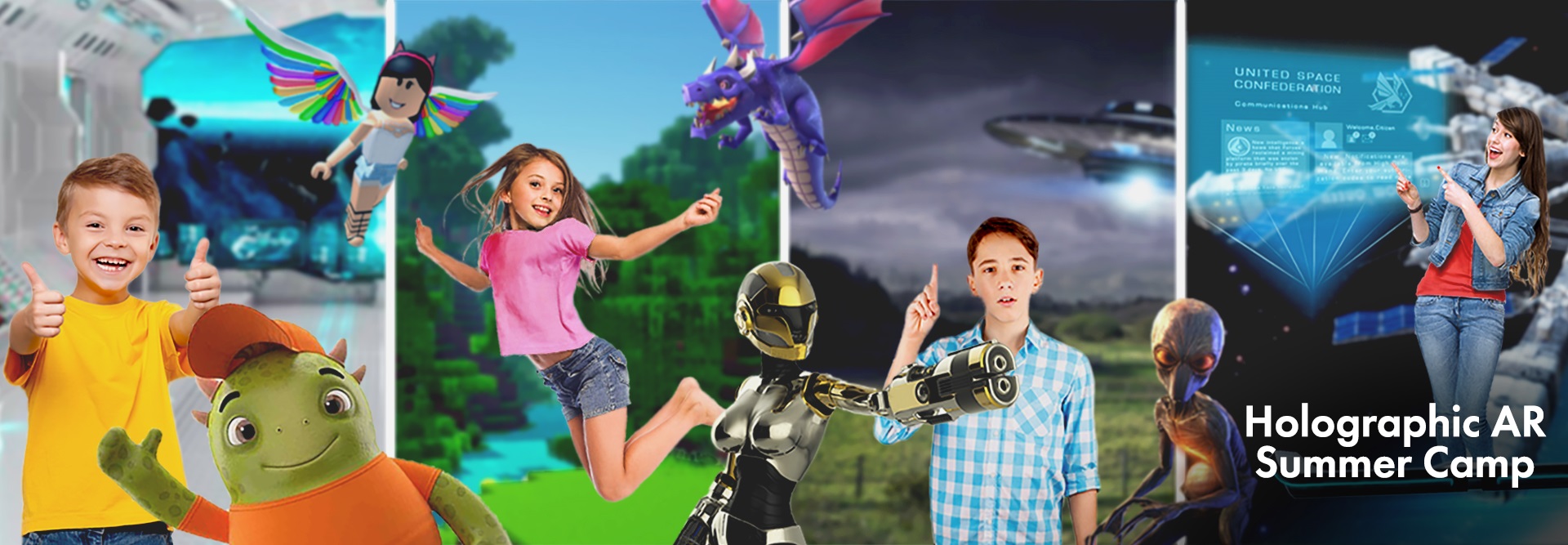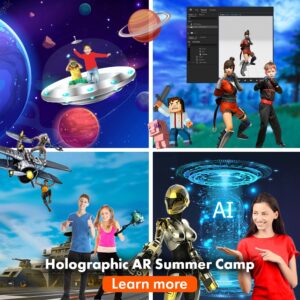
Why do I need to learn Holographic AR programming? What can I learn when learning about Holographic AR? These are questions often raised by parents.
Here are typical skills students that students have gained through the fun-filled and project-based Holographic AR programming:
- STEAM (Science, Technology, Engineering, Art, and Math) Concepts
- Creativity
- Design thinking
- Interactive storytelling
- Empathy
- UX/UI (User experience and user interface) design
- Programming
- Effective collaboration
- Communication skills
- Problem solving
STEAM concepts
If you are familiar with the technology or education sector, you have undoubtedly heard that STEM, an educational curriculum focused on science, technology, engineering, and math, has evolved into STEAM to include arts. STEAM education is considered crucial in helping future generations stay competitive with the global workforce and guiding the current generation to create jobs that facilitate economic growth.
Problems in the real world are often complicated and disorganized. Relying on the knowledge of one subject is not sufficient to harness challenges of this scale. People need to apply skills learned across subjects. STEAM programs were invented to demonstrate and advocate this type of interdisciplinary learning. Holographic AR itself is a harmonious interplay of different STEAM concepts. Through creating Holographic AR projects, students discover and practice STEAM skills in a fun, rewarding, and effective way. Here are some examples of what students can accomplish with this unique learning tool. For science, students study perspectives, perceptions, and how to attract people’s attention by appealing to their senses. For technology, they learn logical operations and computer programming using a visual programming language, iCreator. For engineering, they set up the various hardware required to execute their projects. For art, students practice designing immersive experiences with images, videos, and soundtracks. And for mathematics, they gain hands-on experiences manipulating and animating 3D models and solving logic problems.
Creativity
Most people think of creativity as a natural born talent reserved for the lucky few. When complimenting someone on being creative what they really mean is “you are so fortunate to be bestowed such a rare artistic trait at birth”. This cannot be further from the truth. For one, every person is creative, though not everyone has the chance to put his or her creative energy to good use. Those unable to express their creativity are usually dubbed as “just not having it” and excluded from future innovative endeavors. For another, creativity is not static. Like many other skills, the more you train your brain to think creatively, the more proficient at it you become and the less you use it, the duller it gets. Also, creativity is not exclusive to the arts. You need creativity in solving problems across all disciplines from physics to medicine to philosophy. For those looking for opportunities to engage their creativity in a broader scope, Holographic AR offers the perfect solution. Learning Holographic AR allow students to discover, express, and practice their innovative thinking skills through multiple mediums including storytelling, animation making, computer programming, and public speaking. Holographic AR curriculums are professionally designed to encourage original thinking. There’s no exam, no grading system, no right or wrong answers, and no rules on what a student should accomplish. Students get to put their wildest imaginations to work and develop genuinely ingenious solutions that do not need to conform to an arbitrary standard. If they don’t like their work, they can restart from the beginning. If they have too much to say, they can do that in a sequel. Holographic AR education programs give students absolute creative freedom that a curriculum based on rote memorization, drills, and standard testings cannot provide. In addition to experience and autonomy, inspiration also plays a vital role by providing a breeding ground for unconventional ideas. Fortunately, for aspiring creators, inspirations are everywhere in a holographic AR learning program. From playing to creating to evaluating holographic AR experiences, students gain inspiring insights into the making of a revolutionary product.
Design thinking
Design thinking is an approach to problem solving that focuses on the user. Practiced by many corporations and innovators around the world, this methodology is extremely effective in harnessing complex problems and building user-centric products such as an AR experience. The six-step holographic AR design process Integem practices is an extension of the five-step model proposed by Stanford’s d school. The extra step involves identifying an audience at the start of the thinking process because in an immersive experience, the audience is no longer just a passive consumer, but an active participant who needs to be acknowledged. The complete process consists of defining the target audience, emphasizing with the audience, crafting a story, preparing materials and creating the story in iCreator, testing and refinement. Through design thinking, students learn to challenge existing assumptions, empathize with users, and experiment with unconventional ideas through trials and errors. These skills are invaluable in tackling a vast number of challenges both inside and outside of the classroom.
Interactive storytelling
Interactive stories progress in a non-linear fashion based on users’ inputs. What actions lead to what outcomes, how one scene transitions to the next, what starts and ends a program are essential questions students need to address before using iCreator [link icreator article]. Also worth considering is how to encourage meaningful user participation and how to respond to unexpected behaviors. To make a story worth telling and worth playing with is an excellent exercise in logical thinking and creative decision making.
Empathy
To put yourself in someone else’s shoes and to think like them is easier said than done. Even harder is the ability to construct how someone arrives at a specific sentiment and to recreate his or her thought process. Designing immersive experiences gives students many opportunities to practice this type of empathetic thinking. To tell stories that make an impact on an emotional level, students have to continually put themselves in the positions of their audience and exam whether an element in the story evokes a particular emotion as intended. Only then can they create experiences that resonate.
UX/UI (User experience and user interface) design
Students also gain an understanding of UX/UI design through holographic AR programming. As they search for images, compose animations, and decide on the typefaces and color schemes to use, students put design principles into practice and develop an eye for aesthetic harmony. Another critical aspect of well-designed user experience is ease of use. Usability means a few things when it comes to designing holographic AR. Chief among them is how easy it is for users to physically and emotionally interact with the virtual environment. In Integem’s education programs, students experiment with core design concepts and learn to approach UX/UI design from multiple perspectives.
Programming
Students program holographic AR experiences using Integem’s visual programming language ICreator. If you are unfamiliar with the term visual programming, it helps to revisit the definition of programming. Programming, in essence, is instructing computers on what to do, and sometimes how to do them. The most common way to do this is through texts. This is commonly referred to as textual programming and is how most applications are written today. Visual programming, on the other hand, allows people to communicate with computers through graphic elements. People program by manipulating visual objects, not by writing lines of code. Visual programming is an excellent way to introduce students to programming because it’s more perceptible, more intuitive, and more in tune with how the brain works to perceive new information.
Effective collaboration
Holographic AR curriculums are designed to mirror what it’s like to develop an innovative product in real life. A revolutionary product is rarely the work of a single person, but often the collaborative effort of many brilliant minds. In holographic AR classes, students have the opportunities to work together to brainstorm ideas, present possible solutions, and to experiment with different configurations. Students learn three valuable skills through teamwork: how to communicate with others, how to learn from others and how to reach a consensus among diverse opinions. Effective collaborations produce quality products that reflect the combined wisdom of all contributors and sometimes even more: sparks of insights that arise when they put their knowledge together.
Communication skills
Communication skills are perhaps the most important soft skills to excel at. Integem aims to incorporate communication exercises throughout its holographic AR education programs. Students communicate with their team members to discuss solutions and exchange feedback, with the computers when they program AR stories using iCreator, with the audience as they showcase their products, and with the teachers when they ask and answer questions. As they become more confident in their public speaking capabilities, they seek harder questions to ask, more in-depth topics to discuss, and more empowering mediums to share their insights.
Problem Solving
Problem Solving is the process of working through details of a problem to reach a solution. It is a universally required job skill that applies to any position and every industry. It involves creative and critical thinking. When testing their Holographic AR projects, the students often found bugs of their projects. They will first need to define what the bugs are; learn to diagnose where the bugs from, come up several possible ways to solve the problems, and then decide an optimal way to solve it. During the process, the students will learn about how to come up practical solutions. Sometimes, the students may come a “total solution”, that may take impractical amount of time and resources. The instructors will encourage the students to further optimize their solutions that can be done practically in a reasonable amount of time. In this process, the students learn how to solve problems strategically.
It is often hard to learn one thing and gain all the above skills. However, Holographic AR programming is very unique. In different from other programming languages, Holographic AR can literally transfer every sentence of human language into vivid and logically designed Holographic AR experience. The creation process is a highly creative, logic, interactive, and visual communication process. It naturally integrates design thinking process, UX/UI design and problem solving in the creation process. It helps students learn and grasp STEAM concepts fast and efficiently. It reinforce students to be empathy, and collaborative. Most importantly, the entire learning process is very fun, and rewarding.



Recent Comments